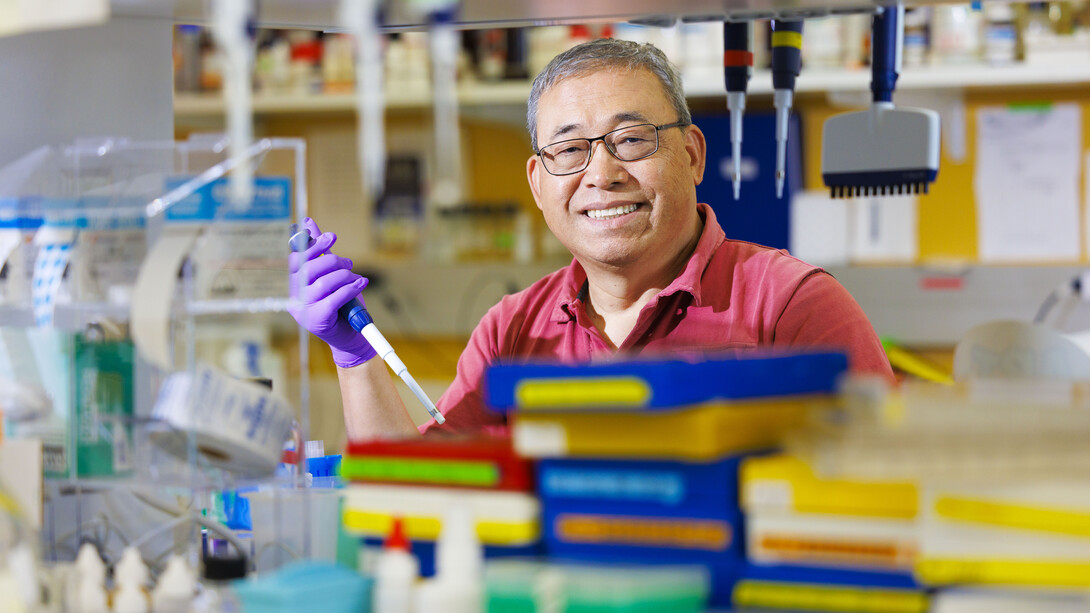
A Husker virologist has received a grant from the National Institutes of Health to advance the 40-year quest to develop a vaccine against HIV, which infects about 40 million people globally and has caused an estimated 42 million deaths since the epidemic began.
Qingsheng Li, Willa Cather Professor of biological sciences and a member of the Nebraska Center for Virology at the University of Nebraska–Lincoln, recently received a five-year, $3.5 million R01 grant from the NIH to advance work on an mRNA vaccine against HIV. His approach may overcome what has been one of the most intractable obstacles in the field: the virus’ ability to rapidly mutate, which has led to hundreds of thousands of HIV strains. By targeting parts of the virus that are consistent across this vast genetic diversity, Li’s formula has potential to achieve a level of efficacy that has so far eluded the field.
The formulation of mRNA packaged inside lipid nanoparticles is also novel for its temperature stability. Vaccines using mRNA typically require ultralow temperatures offered by specialty freezers, which are scarce in developing countries. Li’s design would enable storage for several months at about 4 degrees Celsius — the temperature of an average refrigerator.
“We think this approach has great potential, particularly in poorer countries, because it’s difficult for them to access ultralow-temperature freezers,” he said.
For this project, Li and long-term collaborator Ma Luo of the University of Manitoba and the National Microbiology Laboratory in Canada drew guidance from research on a group of female sex workers in Kenya who, despite repeated exposure to HIV, remain resistant to infection. Their natural immunity stems from a focused immune response of virus-specific CD8 T cells, which are key to clearing infections, around certain sites on the HIV virus that are vital for its survival and replication.
To mimic this natural immunity, Li’s team developed mRNA encoding 12 novel HIV immunogens — molecules used in vaccines that trigger a particular immune response — that correspond to these sites. The researchers packaged this mRNA inside lipid nanoparticles, which allows for safe transport to target cells.

A major advantage to focusing the vaccine on these 12 viral immunogen sites is that they are conserved globally across most HIV subtypes. The team’s early study in monkey models showed that about 80% of the monkeys were protected against SIV — a monkey version of HIV — transmitted through a vaginal route. Now, the team will test rectal transmission — the most common route of HIV spread in the U.S.
Another key difference is that previously, the team administered the vaccine immunogens one by one. In this project, they will combine the 12 immunogens into a single vaccine, a key step toward manufacturability. This approach will also prompt a stronger immune response.
The vaccine’s ability to withstand higher temperatures could be a major innovation in the mRNA vaccine space. The COVID pandemic fast-tracked development of mRNA technology, but the material’s propensity to break down rapidly and easily at average temperatures has been an Achilles’ heel to global deployment. Li’s “cold chain friendly” design — for which he is currently pursuing a patent — could open the door to increasingly extensive use of mRNA vaccines.
Li’s project comes at a time of debate in the research community about the possibility of ever developing an effective HIV vaccine, a problem that has vexed scientists since the 1980s. Designing a successful vaccine has proven extremely difficult: Only one clinical trial has shown any efficacy, and it was only 31% effective — not robust enough for regulatory approval.
At the same time, treatments — primarily antiretroviral therapies and pre-exposure prophylaxis — have become increasingly effective, blunting the public’s memory of the HIV pandemic’s height in the 1980s and early 1990s. But the treatments are expensive, not accessible to all and some are associated with health problems like heart disease, kidney impairment and bone loss. And antiretroviral therapies do not eradicate HIV; they suppress it to undetectable levels, meaning the virus will “wake up” if the patient forgets to take medication, forgoes treatment or loses health care access.
Effective antiretroviral therapies also require early detection of the virus, which is sometimes impossible in developing countries and difficult in the U.S. because of social stigmas.
That’s why Li and many other researchers keep pushing forward despite scientific setbacks, waning public interest and a divisive political environment surrounding vaccines. Solving the puzzle, he believes, will open the door to quashing other pathogens.
“Some people believe we will never have an HIV vaccine, but we truly believe vaccines are the most cost-effective method to prevent infectious diseases.
“Boiled down, it’s a fundamental scientific question: Why, using currently available scientific methods, can we not find a solution to the HIV vaccine? If we answer that question, it won’t just resolve the HIV vaccine, it’s going to resolve a lot of other vaccine challenges.”
NIH R01 grants are the agency’s original and oldest grant mechanism. They provide support for health-related research and development based on the institutes’ mission.
Share
News Release Contact(s)
Tags
High Resolution Photos

HIGH RESOLUTION PHOTOS








